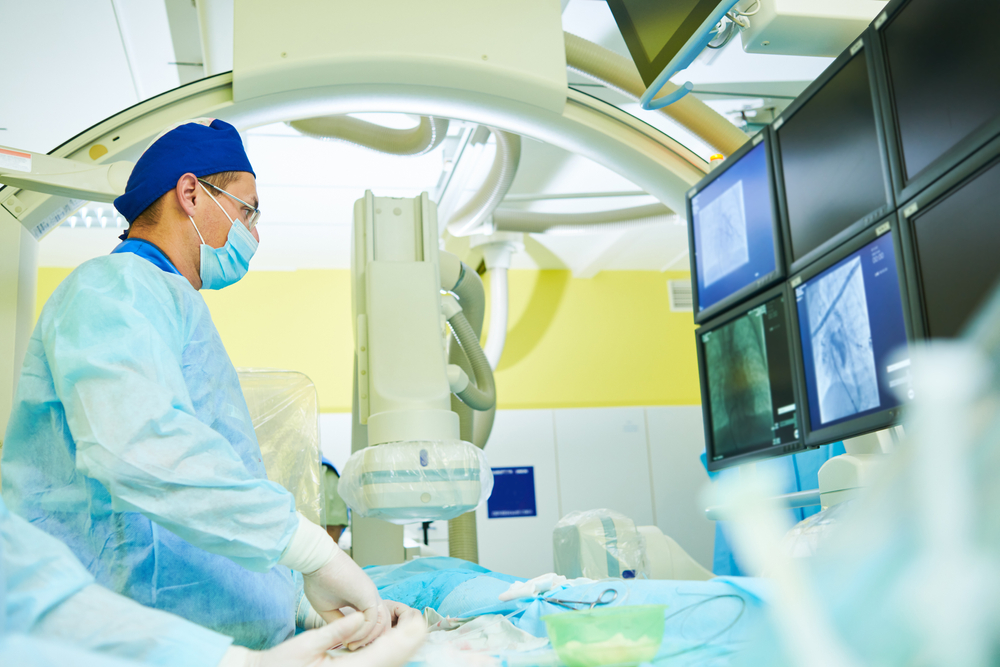An interventional radiologist plays an essential part in designing our patient’s treatment plans and below we will explain their role.
Interventional Radiologist
Interventional radiology is a medical specialty that uses a variety of imaging techniques to obtain images of the inside of the body. Interventional radiologists carefully interpret these images to diagnose injury or disease and perform various interventional medical procedures.
Interventional radiologists use imaging techniques such as X-rays, MRI (magnetic resonance imaging), fluoroscopy (an X-ray technique that can see internal organs in motion), CT (computed tomography), and ultrasound. Interventional radiologists perform a wide range of procedures such as treating tumors, inserting tiny instruments and thin plastic tubes (catheters) into the body through arteries or veins, performing organ biopsies, or placing stents. These images are used to guide catheters and instruments exactly to the area where surgery or treatment is to be performed. This reduces the need for traditional (open) or keyhole (laparoscopic) surgery because the treatment can be delivered through a small plastic tube the size of a straw.
An Interventional Radiologist’s Role In UFE
Continuous advances in technology mean that the range of diseases that can be treated with interventional radiology continues to expand. Interventional radiologists perform a variety of procedures, including Uterine Fibroid Embolization and Prostate Artery Embolization (PAE). Uterine fibroid embolization or uterine artery embolization has been clinically shown to reduce major symptoms of fibroids, including pelvic pain and pressure, excessive and prolonged bleeding, and frequent urination. It is usually done on an outpatient basis and takes about an hour. In contrast to a larger surgical incision, UFE is performed through a tiny needle-like puncture in the thigh to access the arteries that supply blood to the fibroids.
UFE is performed by an interventional radiologist (IR). Interventional radiologists are physicians with six to seven years of post-medical school specialty training who require subspecialty fellowship training after residency training in diagnostic radiology. They are certified by the American Board of Radiology. The concept behind interventional radiology is to treat patients using the least invasive techniques currently available to minimize patient risk and improve health outcomes. Using modern imaging technologies, interventional radiologists can effectively treat a wide variety of complex medical conditions with unprecedented precision through pinhole incisions. This reduces risk, reduces pain, and shortens recovery time. Many of the conditions treated with these techniques involve the vascular system, and because of this focus, interventional radiologists are considered vascular specialists.
What Does An Interventional Radiologist Do During A UFE Procedure?
Interventional radiology is an effective alternative to surgery, resulting in shorter recovery times and fewer side effects. There are some similarities to open surgery, but the procedure is generally brief and does not require hospitalization. Below is a description of what you can expect during a UFE procedure:
- Before treatment: You will meet for a consultation with a board-certified interventional radiologist who will review your medical history and discuss treatment options. Lab tests may also be performed during this appointment. If you are a candidate for an interventional radiology procedure, it will be scheduled. Before your procedure, you will be asked to read educational materials and follow preoperative instructions. This may include fasting and not taking certain medications.
- Treatment day: In most cases, you will receive injections at the beginning of the procedure to provide any necessary medicine or sedative. Patients undergoing interventional radiology rarely receive general anesthesia. Fibroid embolization begins with a tiny pinhole in the groin. This puncture allows the interventional radiologist (IR) to access the arteries that supply the fibroids. Using a specialized X-ray machine, IR inserts a catheter (a small tube) through the needle-like puncture in the uterine artery and guides it near the site of the fibroid. When the IR reaches the fibroid site, an embolic material (small beads) is injected through the catheter into the blood vessel supplying the fibroid, depriving it of oxygenated blood. Lack of oxygen can cause fibroids to shrink. The embolic material remains permanently in the blood vessels at the site of the fibroid. The catheter is then moved to the other side of the uterus. Once IR has completed the embolization of both uterine arteries, the catheter is carefully removed.
- Post-treatment day: The duration of the procedure varies from case to case, but is usually less than an hour to perform. After the minimally invasive procedure, you will be taken to the recovery room and closely monitored. After a few hours, you can have someone drive you home and help with post-operative guidance.
No two patients are the same. At 1Fibroid Center, we believe in a team-based approach to patient-centered care to determine the best treatment for each patient. Specializing in the treatment of fibroids, our experienced gynecology and interventional radiology teams provide state-of-the-art uterus-sparing treatments to improve your quality of life and allow you to quickly return to your daily routine. Call (212) 991-9991 to make an appointment.












